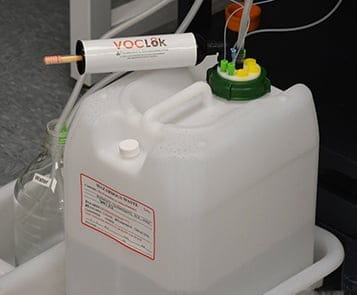VOCLok: A Solvent Waste Collection System You Can Trust
HPLC machines are a staple of analytical labs across the country and around the world. If the hazardous waste you’re collecting is coming from HPLC units, our solvent waste container system will ensure your lab is in compliance with RCRA regulations. RCRA requires that all of your containers be closed when not being filled.
Designed by EHS professionals for compliance, safety, and flexibility, the VOCLok HPLC solvent waste collection system prevents exposure to toxic solvents and ensures compliance with RCRA closed-container regulations.
- Closed system for lab scale waste collection
- Carbon exhaust filter scrubs rogue VOCs
- Versa cap technology makes it easy, fast, and safe to change full containers
- Custom cap configurations
- Many container sizes to help reduce waste volumes
- Minimal maintenance, built into your SAA RCRA compliance program
- At half the cost of other solutions
Easy to Install and Maintain
Our experts help you:
- Select the right containers and caps
- Install the system to ensure setup for optimal performance
- Install plugs, hose barbs, tubes, and grommets to ensure closed-container compliance
- Maintain the system and stay compliant
- Change containers and caps
- Train your staff
HPLC Solutions That Work
Many solvent waste container systems used in pharmaceutical, healthcare, and higher education research do not appropriately address the safe or compliant collection of hazardous waste. You can avoid RCRA violations and citations with the right equipment. If you want to save time, money, and eliminate worries about compliance — give us a call today.



